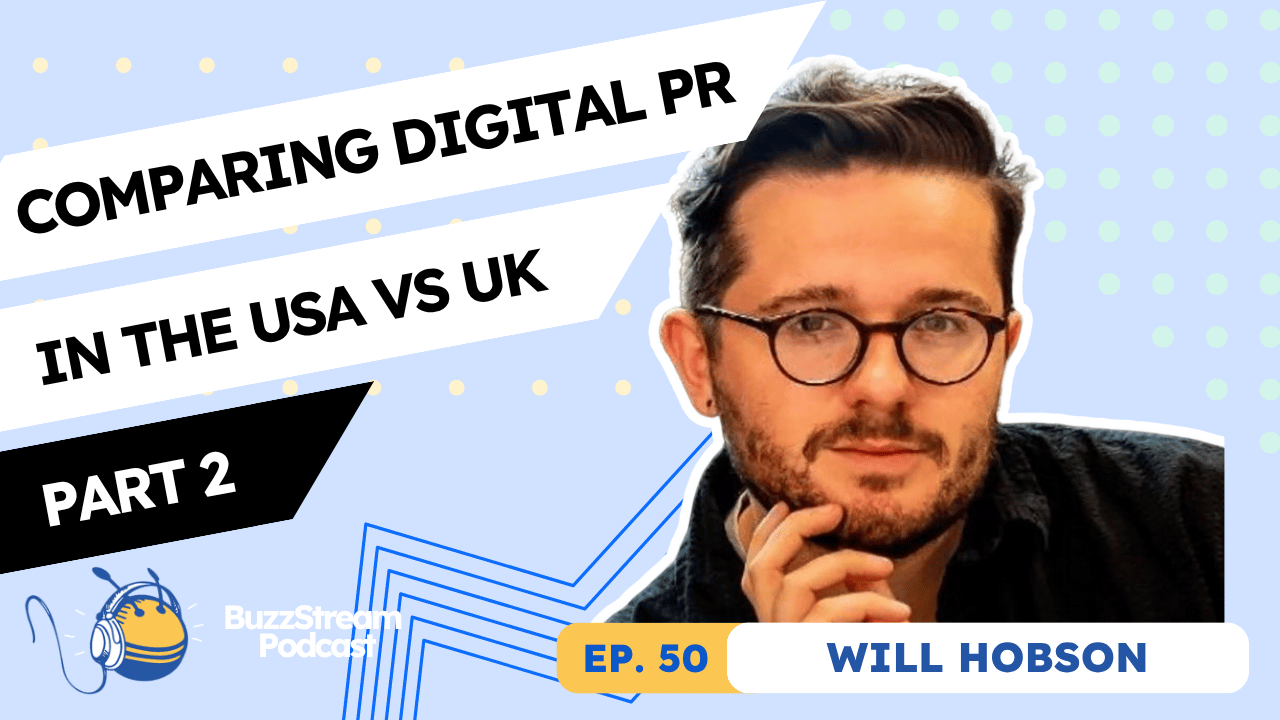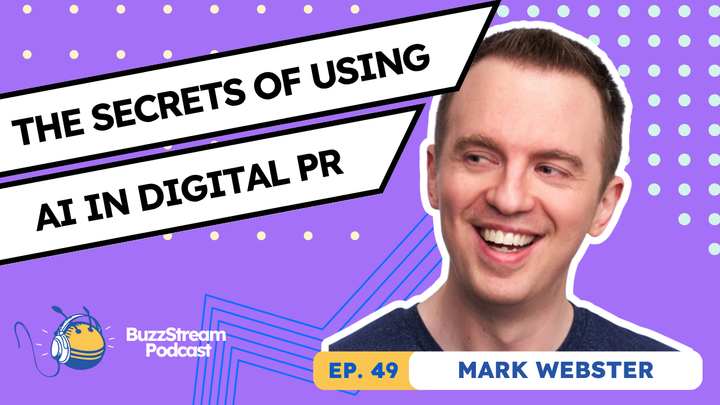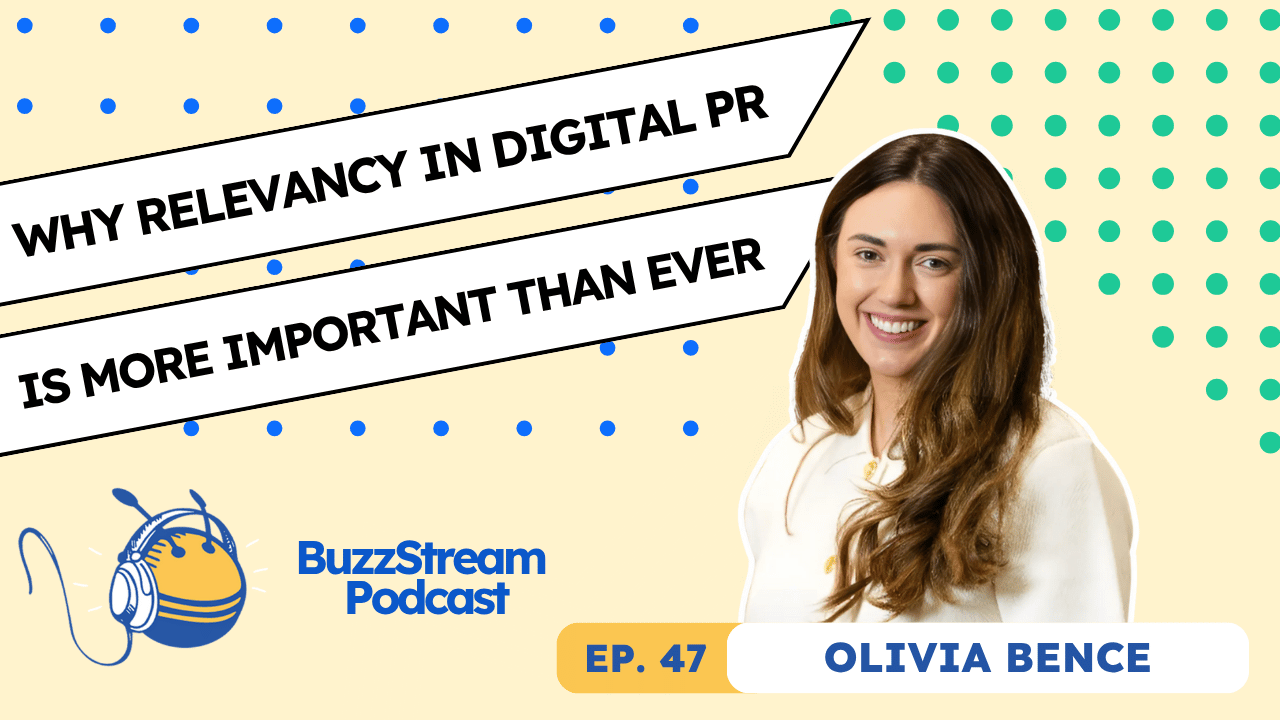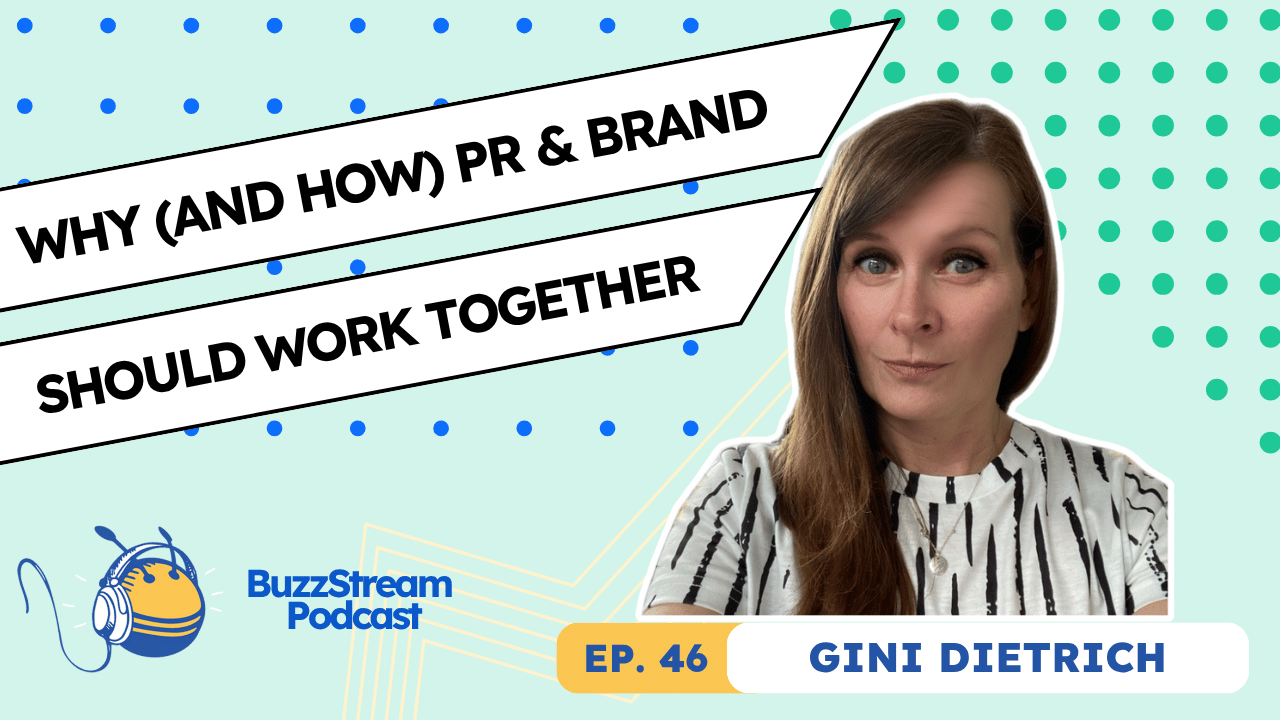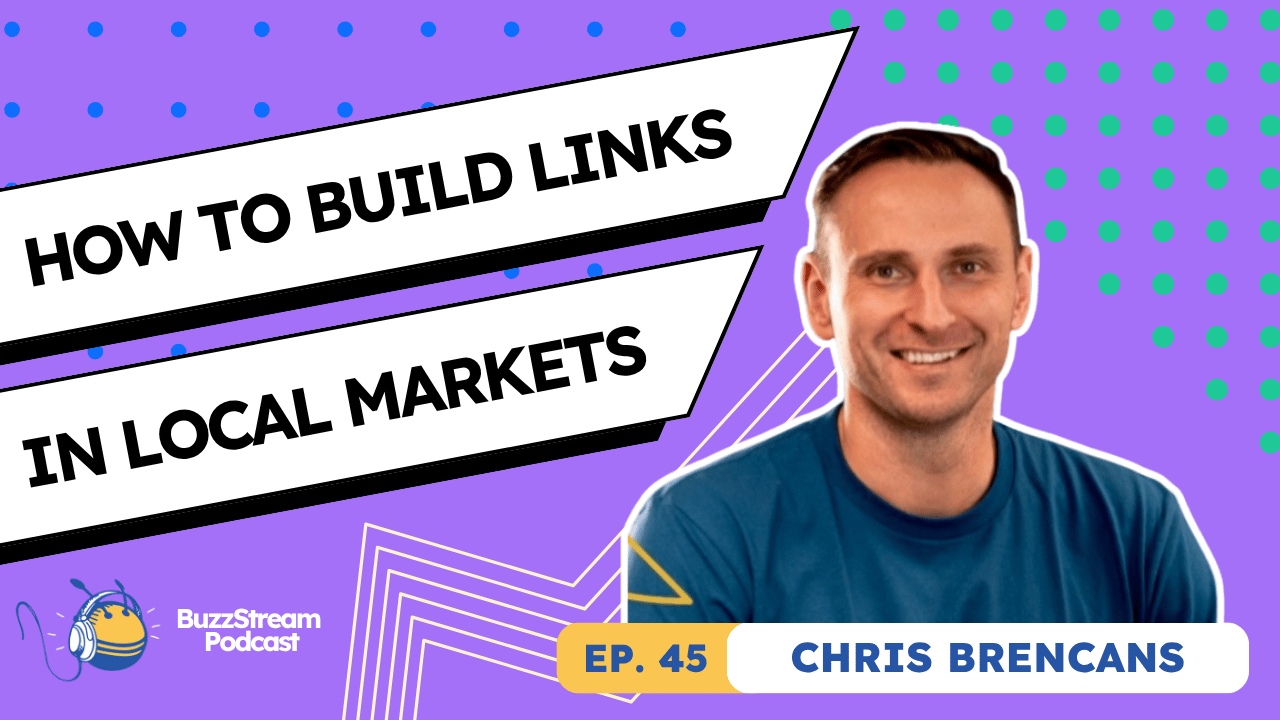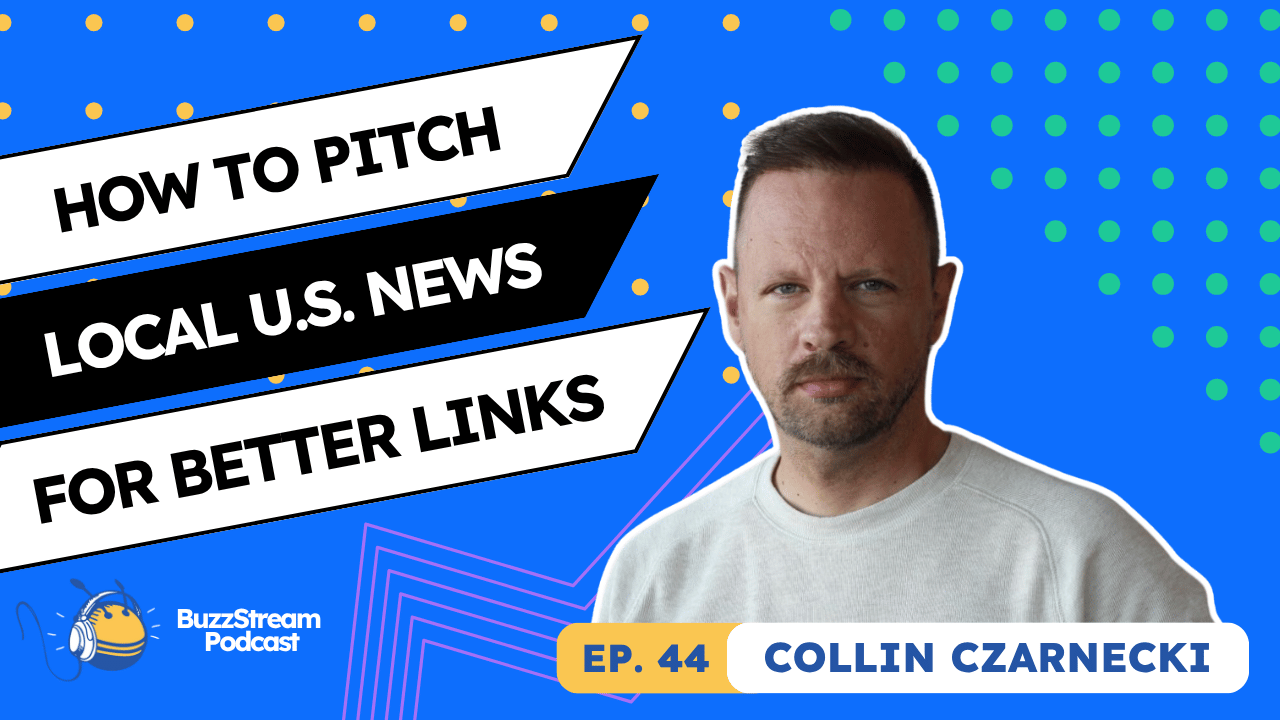Table of Contents
When John Mueller tweeted that he liked digital PR, there seemed to be a mad scramble for U.S. agencies to add it as a service.
However, I’ve always felt that the US had much to learn from the UK. From creative ideas to strategic workflow, they seemed to be years ahead of the U.S.
So, I set out to find someone to talk to about the differences in digital PR between the UK and the U.S.
I also wanted to see what insights I could glean from UK teams with much more experience in the field.
When I learned that search-first creative agency Rise at Seven had appointed Will Hobson to lead growth in the United States, I jumped at the chance to chat with him.
And I was not disappointed.
In this podcast episode, Will shares his expertise on how digital PR has evolved and the critical differences in digital PR practices across the Atlantic. He offers invaluable insights for brands and agencies aiming to launch their own digital PR campaigns.

(Below is a slightly modified transcription.)
Where did the term digital PR come from?
Yeah, that’s a big question to start off with, which is great. I’ve been in the industry for just over 10 years now, and when I first started, I felt like I was working in a search agency in the UK called Branded3 at the time. And when I first started in the industry, I felt like it was probably the start of the change.
So a lot of people like, if you think back to like pre like Panda, et cetera, Penguin, like pre to all that, they would kind of find different ways to buy links and to kind of almost manipulate Google in certain ways.
When I joined, that was straight after those algorithms would roll out, and everyone would see a lot of penalties. So they were looking at different ways to build links.
And I think what they’d notice at the time was, okay, great. This is how we can build links: by creating interesting stories online, like through PRs.
My background is traditional PR. Before I started in digital, I worked in traditional PR agencies and with charities and all sorts of different things, where I looked at the reputation side of things and storytelling from a brand point of view that wasn’t necessarily to have benefits online.
It was just more storytelling to that brand.
So then that shift kind of happened by 2014 where people were trying to build links naturally.
To me, digital PR means creating an interesting story online that will impact a brand and also benefit search engines.
So it’s not necessarily just building links for a link sake. It’s creating interesting stories that are relevant to brands, that they’re actually going to drive something that’s super, super valuable to the bottom line or to the wider centric kind of brand metrics that might be looking into as well.
So it’s really about kind of creating that interesting, compelling story for a brand that’s super relevant and also has benefits online.
So how I look at digital PR is kind of creating great content with benefits online too, is kind of almost like a secondary.
It’s still about that PR story, that PR tactic and that relevancy to a brand, because I think you can get linked by just creating interesting stories, but it has to—for me anyway, and what I believe it —has to be super relevant to the brand; it has to be fitting to what they’re talking about to actually have that wider value as well.
So, really generating demand and being able to kind of really resonate with the audience of that brand, I think, is super important.
Is it still considered digital PR if there are no links involved or no SEO?
I think the line between digital and traditional is just becoming more blurred.
I’ll give you an example. One of our clients is a pet brand. They sell all sorts of different clothes, food, and other things for pets, specifically dogs.
And we landed one of the UK TV shows, which is like Good Morning America.
When we landed that piece in that show, the amount of traffic that came to our site and the amount of purchases that we made impacted our bottom line and revenue.
So, although if you don’t get a link, I don’t think that’s the end of the world from an SEO point of view because although great, we want those links back to our site.
But if you’re also getting print coverage, if you’re also getting everything else, from a TV broadcast point of view, it’s going to have that benefit and that halo effect online for you as a brand.
So I’d say it doesn’t necessarily matter if we don’t get that link.
Obviously, we’re going for it, but I just want people to be talking about the brand because that’s going to have an impact on the brand specifically.
How do you quantify non-linked earned mentions (like TV spots)?
When someone brings up the cost per link, I usually say to our sales team that it’s a red flag.
I’m like, “I don’t want to talk about it.”
And it’s not because I’m trying to avoid a difficult conversation or anything like that.
It’s more so that I want to be talking about wider things, like, “How can we help from a traffic point of view, a revenue point of view, what is our wider strategy?”
So the way that it works from our point of view is like the digital PR and the link building side of things, they usually sit within wider search strategies.
So, any account that we have—whether it is just a PR strategy or if it’s like full service—that we’re talking about, like SEO content, technical, everything,we’re always looking at like, well, what are we trying to achieve?
Are we trying to increase rankings for this keyword?
And how are we going to do that?
And how can we report that back to an increase in revenue?
So it’s trying to tie our goals with the wider business goals that we’re working with for our clients.
So it’s not just looking at, okay, we’re going to get you on USA Today. And then that’s sorted.
It’s more about, well, what is it? What is that wider goal going to be?
And, I’m also very transparent about, okay, not every campaign is going to work. That’s why we want to necessarily have several different kinds of strategies working at once so that we can kind of have almost a press office that happens like every single month that we’re doing more smaller reactive stories.
Then we’re having like more of your campaigns activities. So we’re doing those bigger brand moment pieces.
We discuss it around that situation, making sure that our goals aren’t just about that; they’re actually also looking at the wider strategy, so we can report back on that.
What are the main differences between digital PR in the US vs the UK?
I’d say in the UK it’s quite established ’cause we’ve had it for, we’ve been, like I said, I’ve been working in digital PR for 10 plus years now.
So I’d definitely say it’s more well-established.
I do think the US view of it, and this is my opinion, so people might wanna shoot me down, but I think it’s, it is a little bit of a different approach.
I think they see it as a little bit more, not as bread and butter as we see it in the UK.
And what I mean by that is like in the UK, it’s kind of like a given, like the teams are really clients really open to it.
It’s really kind of open and they know what it is.
It’s earned. It’s all about kind of traditional PR tactics for a digital spin.
Like I think they’re so used to it was, I think we’re so at that early stage in the US where it’s kind of that cross between link building and digital PR. So it’s not necessarily just about a certain tactic.
It’s more about the strategy of PR.
What we’re bringing to the US is, well, “how can it be pulling different teams together?”
“How can we work with the brand team?”
“How can we work with the social team? Like, how can we work in with various parts of a business rather than necessarily just the search team that we’d be working with?”
So I’d suppose in the UK, I feel like we’re, we’re quite far along that journey.
And a lot of our clients will speak to the SEO team, but we also speak to the brand team. Whereas I know it’s in US teams, we tend to just speak to the SEO team at the moment.
I feel like in the next, like, five years, we’ll be, it’ll be kind of where the UK is now, really.
So, that’s kind of how I see it from the industry perspective, a little bit further, like, a little bit less developed, a little bit less known, and I just think that’s purely because of the size of the US.
Just because it’s so big.
I feel like the, because the UK is a lot smaller, I feel like it can just travel quicker, like quicker through throughout the country versus the U. S., because it is literally, I’m just guessing, scratching the surface of how big the U. S. is.
What takeaways can the U.S. learn from how to sell digital PR in the UK?
Yeah, I think definitely from the results point of view that we mentioned earlier, but I think it’s also showing the wider teams, how we can help.
And what I mean by that is, say you were to go into a brand and it’s like an e-commerce brand, retail brand, and we’re like, okay, great, “Can we give them data from a search perspective and a trend perspective that’s going to help with sales?”
“Can we start to pull different teams together? Can we show the PR team how we can support them?”
Like if they’ve got a collaboration or any interviews coming up with a certain like. I don’t know if, say, it was a retail brand and they had a collaboration with a certain star or something like that. It’s like, how can we support them?
So I always think the way that we’ve like expanded our relationships is by making our clients jobs easier. So if we can do that with like any U.S. brands, I would definitely recommend that. And how we can almost make ourselves indisposable really as a brand ourselves to help educate theirs teams, help pull them together, help their work lives go a lot smoother, really.
So I think it’s all about showing them how you can help as well as showing them the return on what you’re doing and making sure that that fits within their strategy.
Should digital PR teams communicate directly with traditional PR teams?
It depends on like the length that we’ve been with them because obviously it needs to be over a good amount of time.
But at the beginning when we work with the brand, we want to meet those wider teams and pick our key stakeholders and to make sure that we’re going and building a relationship with them, finding out how we can work with them better, and then also reporting back on what we’ve done.
So for an example, say we’re working with a new brand and they might include some of those PR metrics, even though we’re not reporting them, not them to our key stakeholder, we’re showing them different metrics in terms of like, okay, this is where your rankings have improved, this is where your traffic’s improved.
And then we’ll say from a PR point of view, this is how brand sentiment is; this is how X, Y, Z.
So it can kind of include what they need as well. And I think it’s good when, our clients are lifting our decks and then using them as a wider kind of showcase to the rest of the team.
So again, making that job easier, I think is the most important thing.
What are some differences between pitching and ideating in the US vs the UK?
I think one of the biggest things that I’ve noticed, working in the UK versus the US is kind of like lead time on press, which I think is taking a lot like in the UK, you could outreach a story like on a Monday and get pick up on Monday afternoon or pick up on Tuesday if it’s like a really good story.
Whereas like, I’ve noticed a lot longer lead times in the US.
So I think you definitely have to tailor something to that and also tailor your strategies to that.
We actually outreached a story for a beauty brand that we’re working with in November and I think it got picked up like last week. So that was like, took like four months.
I was like, “Is this a joke?”
We also work with a really big health brand. We know the lead time on health is much longer as well, with a lot of approvals.
So, definitely tailor the story to the market. That works in every market, not just the UK versus the US.
It’s the same internationally; it’s the same kind of across Europe. Every story doesn’t necessarily land.
So, I recommend noticing what stories are working within your market, how the media is different, and how the landscape is different.
And then just kind of making sure that, like, is that strategy going to work?
So, for example, if you’re doing a creative campaign, like a Spice Girls piece, it’s like, well, “What makes that relevant to that popular culture moment now that’s happening in the US?”

What is it that’s relevant now?
I think it’s about consuming the media as well.
I noticed that when I’ve lived in the US., I tend to have much, much stronger stories in my mindset when I’m constantly consuming US media versus U.K. media.
What I mean by that is just watching the news stations in the morning, watching the adverts that are constantly on Twitter.
I just think it’s so much easier when you’re actually in that country.
When I’m in the US, I’ve come up with much stronger ideas than when I’m in the UK trying to consume US media.
You’re just walking down the street, and you’ll see a billboard or you’ll see X, Y, Z.
I feel like you get so much more inspiration when you’re actually in that country and seeing what’s happening there and in that moment versus trying to do it remotely from another country.
So it’s kind of about consumption and then being able to replicate something.
I wouldn’t necessarily just copy and paste from country to country; I would make it really, really tailored to that country.
This Spice Girls piece was huge, and they’re huge globally, huge in the U S as well. But, for Royal Mail, the reason why that one works so well is because, Royal Mail is so historic here. Though, not at the moment because they’ve just had a huge scandal, so we won’t be talking about them much longer.
But it’s perfect for them. It’s quite a historic brand. People love the Spice Girls because the partnership works really well. So just be kind of having something equivalent in the U.S. and making sure it’s really tailored to that cultural moment at that time in that country.
Do you have to think about lead times differently in the U.S. vs the UK?
I think it depends on the story, because we’ve had some really good reactives in the U.S., and I think it just depends on who it is and what it is and what type of journalist takes that.
Entertainment writers go fast and like anything about celebrities. We’ve done a lot of things within the fitness industry. When Miley Cyrus released her flowers music video last year, we basically broke down the workout that she did within it.
We just said, like, this is how you can get the workout from home, added commentary in from like a couple of like experts that were at the brand that we were working with.
And then I reached out, and that went everywhere, like People magazine and Women’s Health, touching loads and loads of different niches.
And that one was really quick.
We also do reactive strategy for the healthcare brand that I was talking about. And that could take months sometimes, but we get it, and the publications are kind of worth it because you get in on places like Healthline, which is really kind of authoritative.
So it’s kind of like, yeah, this is going to take a while, but they are going to be worth it in the end.
So I think it’s kind of like a mix and making sure that if you’ve got a big campaign, try not to tie it to something.
I’ve done that in the past because sometimes they’re the best ones. You’re like, “great the Super Bowl’s coming up and we want to do a campaign.”
But then you’re like “oh my god it’s like three weeks, left two weeks left!”
And then you’re like “oh it’s gone!”
So it’s kind of like having a mix of those types of campaigns, but don’t do every campaign with a tight window because you’re making it very hard for yourself.
Does local news in the U.S. make it easier to do those city-ranking pieces?
Yeah, totally.
I think in the U.S., that’s what we tend to do. We do those rankings as well, but we tend to mix it for an account. We’ll probably just do like one or two of those maximum a year.
But then it’s like, “Great. What other things can we touch it?”
We’re huge on popular culture, whether from a film or TV point of view or anything from celebrities, anything that we can tap into that everyone’s interested in.
I just feel like probably the most recent example that was really banged was something for a Marvel film.
So we work with an education brand, and they do online tutoring.
When Marvel’s Eternals was released there was a there’s a deaf actress in there, and we noticed that demand for sign language courses had increased around the premiere of the film.
So, we then released this as a story.

We just did a small story that took the stats that we had on site, released them as a press release, and it got in every publication, including ScreenRant, IMDB, and all these huge film and TV publications.
And then all the actors started sharing it and then posting it on their social channels and like stuff like that and it got engagement.
So anything popular culture wise, we kind of like try and weave it into our brands.
When we have a travel brand, we’ll look at Barbie destinations or similar things.
Or there’s a Netflix show that’s going huge in the UK at the moment and the shop featured in the Netflix show uses our payment brand system.
So we’re then able to kind of like get them involved in that as well.
So I think it’s like popular culture is definitely a huge, huge strong point.
How do you ideate for tough brands like B2B or brands in “boring” industries?
I actually love B2B brands. We don’t necessarily talk about a lot of the B2B brands we work with, but I still think you can get popular culture in there.
I’ll tell you why.
Obviously, it won’t be as heavy as you would do on a lifestyle brand. But, one of our B2B brands that we work for is a payments brand and they do card machines and terminals for small businesses.
They found they were featured in the Netflix show because we’d gone in, and we literally sent people from the team to the store to see if they used our card machine.
And we were like, they do. Great, we’re going to release this as a story.
And we’ve done loads of different things about that.
So it’s kind of like, again, finding an interesting story. It’s more about the storytelling.
I would say finding a really interesting story.
Another one that we’ve done for them is when were looking at booking systems.
So, if you want to get a reservation—like Rezi—that type of thing. If you want to get a reservation, you can book through them.
And we basically then released a story that was looking at which restaurants had the longest reservation wait list.
And it went global because we just did a story about a small restaurant and pub in Bristol, UK, that had a four-year waiting list for a dinner to literally get a Sunday roast—which is huge in the UK.
It went everywhere.
The New York Post and CNN were covering it.

All because this is the restaurant where you won’t be able to get in for four years.
It’s more about storytelling that you can tell because I often think that when you see a B2B brand, people think, “Ugh, it’s so boring. I don’t know what to do.”
But then I think it’s when you can get the most creative because usually, with B2B brands, you’ve got a little bit more freedom.
There aren’t huge PR teams doing these huge global campaigns.
So you can kind of be like, “right, great. How can I find an interesting story?”
So my advice would be just strip it back.
You need to look at the audience, what they’re interested in, and what they’re into.
Find something that’s an interesting story and then tell that. So it’s kind of making sure that you’ve got something really interesting.
Another B2B brand that we have, for example, offers insurance for utility bills, such as gas and electricity, for small businesses.
And what we do for them is look at which small businesses are driving the most amount on TikTok and looking at influencers.
There’s this one guy on TikTok who’s called the Pool Guy.
All he does is go around and clean everyone’s pool, and it’s so good.
So we look at things like that, and then it’ll be interesting as a story.
So my advice would just be to find something relevant to your audience, but it might be like taking a bit of a step back, looking at the wider pieces, and then finding an interesting story.
So don’t just stick to stuff that’s safe; try new and different things.
But it also has to be relevant to that brand.
How do you communicate expectations to a brand or client who wants to drive conversions from a digital PR campaign?
I think as long as it all fits within the wider strategy. For instance, although that link that we got might not necessarily drive conversions, it did help rankings that then drive conversions.
That’s how we would definitely look at it.
Like, okay, someone might not have clicked through after going on our piece and bought your service or bought your product, but then this is helping the wider strategy to make you more visible.
So they then buy your products.
So I’m definitely looking at it from that perspective.
Some say links from digital PR campaigns don’t do anything to help rankings. What’s your take?
It doesn’t always have to be like a massive number of links that makes an impact.
We’ve done things in the past—that’s probably some of our best work— where it’s more about the strategy behind it than necessarily the number of links.
I’m just thinking back to when we were working with a retail brand that sold beds.
We created a story when The Watcher was out on Netflix. And basically, we noticed that a lot of people were searching for like “how to sleep,” “nightmares,” “how to get rid of nightmares,” and things around that when The Watcher was out.
And our strategy was to increase rankings for TV beds (beds that had literally a TV at the end of them came up), and we created this story and building three or four links into the TV bed section had a massive increase in their rankings.
Obviously, we’re doing like onsite technical recommendations, content, etc around that.
But we got some links from that, like IMDB, Collider, and Screenrant; a couple of really relevant ones within TV and film.
And because we got them directly into that bed section, they had a massive impact.
Do you use tools in different ways based on location?
The only one I would say that is a little bit different maybe is the media database sometimes. The one we use in the UK is not necessarily the best globally.
I’m obviously, I’m not going to say who that is, but I’m just going to say, I’d probably recommend getting a few different ones and looking at your different services depending on the country.
We’ve got a good one at the moment that I’m happy with, but I probably wouldn’t look to use it in the U.S.
I’d probably look at like MuckRack or like a few of the different things like that.
BuzzStream obviously we use globally.
I’d say all the rest of the tools we can use globally.
Buzzsumo.
We use a really cool tool called Glimpse as well. It’s like a plugin for your Google Trends. And it basically can show you anything that’s trending now, but kind of gets it before it’s on the rise.

You can see a lot of trends that might be becoming a thing. It’s sharp. And you can set alerts and different things like that.
So, really, really good for speed.
But now I probably say we use more or less the rest of the tools globally.
I wouldn’t say anything works better in the UK versus the US. (Though I might change my mind in like six months at once I physically get in the US) but, no, not really.
What are your tips for brands or agencies transitioning services into the new country?
I think my biggest thing is to speak to people who are in that market and go and spend some time physically in that market.
I think that’s the biggest thing.
People think that because we’re in such a world where we can just jump on a Zoom call and do anything anywhere, globally, people are like, “Oh, yeah, it’s fine. I can understand that market.”
I honestly don’t think you fully understand it until you’re in it.
As I said, I consume media walking, or on the Tube in London, or if I’m in New York, I’d be going to the subway. And you’re seeing what’s on the Subway, on billboards, in newspapers, everywhere.
Listen to the radio, listen to the news.
Listen to the different stations.
You see what people are talking about, and you see different things—even to the point where my Twitter is global in terms of who I follow.
When you’re on American time, you’ve seen everyone who’s American at once.
If you’re on UK time, you’ve seen everyone who’s in the UK.
So, I think being physically there is my biggest advice.
And I know that isn’t always the best if you want to start it remotely, but I do think it puts you an advantage if you are physically there because you could just pick things up a lot quicker.
How do outreach tactics differ in the UK vs the US?
I’d say our outreach tactics are very universal that we do.
I think I’ve tried different things, and I’ve seen different people’s tactics from different agencies in the US and the UK and we tend to have one that’s globalized, and it’s just about putting the story first.
And what I mean by that is that we write as if we’re a journalist.
We don’t write like, “Hi, I have a press release for you here that’s below.”
Just go straight to the story.
We say, “This is the story that we’re thinking. What do you think?” And nine times out of ten, that is a success.
And tailoring it to that journalist.
So, I’m not writing the same press release, email, or outreach email to a People magazine journalist as I would to the Wall Street Journal.
It’s going to totally depend on who I’m going for, everything that would change.
So I think it’s just making sure you’re tailoring it to that actual journalist and how they write.
So, they’re more likely to read your email if you write headlines in the same way they write their headlines.
Everyone tailors to their own areas. So, if you tailor it to that journalist, you’re more likely to make it into their inbox.
Can you discuss the story or storytelling in your ideas and pitches?
What is the headline? That’s what I mean when I say a story.
I think a lot of times what can happen is when someone comes up with an idea, they go through and develop it and it can sometimes change as you’re going through that development.
So you have to protect that story. And that’s what we say within Rise.
We’re like, if you’re if you’re in charge of that story, you’ve got to protect it.
What I mean by that is that as you’re taking it through the business, if someone says, “Oh, we can’t get that data,” it’s like, “Oh, well, that story doesn’t work then.”
Because if you allow it to allow that story to change, you’re not going to land it in the end.
So, I think it’s protecting the PR idea and the PR hook.
When I was in traditional PR, you used just to write headlines, headlines, headlines.
Like, what is the story and what’s going to be this headline; into that hook?
It’s what a journalist says.
We’ve had a couple of journalists say to us that they’ve stolen our headlines.
They’re like, ‘I love your headlines. We just copied it.” I was like, “oh, great. Love that. Great compliment.”
But when I get coverage, I tend to look at what the journalist has written as a headline and then tweak my headline a bit.
Once I’ve got pick up, you start to then just keep mimicking the story.
So, it’s just really thinking like a journalist and not too broad focus because that’s what I feel like a lot of people do.
They’re like, “We’re this brand, and we’ve got this brand new launch,” and it’s like, “I don’t care.”
It should be like, yeah, what’s the story? Right.
And do those headlines make it into the pitch as the subject line?
Yeah, usually, yeah.
We put that as the subject line, and again, within our emails.
I just get straight to the point.
I wouldn’t necessarily be like, blah blah blah blah blah blah blah blah, all this stuff.
I’d just be like, alright, this is the story.
How much do you personalize emails?
Well, it depends on what we tend to do.
We’ve had a big beauty launch because we do a lot of product PR as well.
And we had a big beauty launch, like two weeks ago, and it was a spin-off of one of the products that was really fast-selling. So I tend to go back to that journalist and say, I know you love this story.
So, we’ve come out with it again, and we’ve done this, and that way, there’s a new product…and things like that.
Random tactic, but I thought if I was in a thread with a journalist, I’d stay with them and just keep going back to that thread and talking to it.
I feel like once people know they’ve opened your email, they’ll come back to you and come back to you rather than have to cold outreach again. Again.
How can people leverage trending topics?
So, one opportunity that we’ve seen—I suppose it is a trend—is that basically, someone, an influencer, posted on TikTok, a content creator, said she was an ex-air hostess. And she said, look, “If you want an upgrade, this is what you need to do.”
And she just said like, “take a box of Krispy Kremes to the air stewards and just like, say thank you for the flight” and she’s like, you will get upgraded.
They will do something for you.
So we basically just took that content—because we work with a lot of travel brands—of that TikTok story, and then we got the headline of like, “New TikTok reveals, this is how you can get an upgrade.”
Then, put that into an outreach email, seeding list, then just started to like outreach that.
So that landed on like IndY 100, New York Post, Thrillist, and a lot of like travel publications and more like lifestyle pieces as well.
So it’s kind of just like spotting opportunity, creating a story and headlines around it, offering commentary from your client within that, and then outreaching it.
How important is the speed for leveraging trends?
So I definitely think like speed is obviously useful.
It doesn’t work for everyone.
If they can’t be fast, I would pick and choose what you do with them and do more planned, smaller campaigns rather than actual reactive pieces.
But it could just be literally spotting a small thing. It’s usually happened in a media moment.
So if it’s happening on social media, it could be that Beyonce announced that she’s got a country album.
So we’re like, great. We could do some country trips, like road trips for a car rental brand that we work with.
So it could just be anything, or it could just be the weather.
Like, could there be snow in New York?
So it’s like, okay, what to do when it snows, like how to de-ice your car, and things like that. So it’s just like spotting the media moment, adding a bit of insight to it, adding thought, leadership, and commentary, and outreaching it.
So just keeping it really simple, but moving with pace.
So that doesn’t necessarily obviously like work for the bigger, like tent pole pieces that you’re going to do.
Do you leverage trends for large tentpole pieces?
Yeah, it depends on what it is. I think it just depends if it’s big enough. Let’s use the Super Bowl as an example.
We know it’s a huge event coming up—like a certain date—and then we’ve got a certain amount of time to do it—just have a secondary backup angle.
So, say you were doing a stunt for the Super Bowl. Also, look at something that’s got data within it that’s a bit of a backup in case you miss that window.
So it could just be looking at something like, within that same campaign page, you’ve also got something like, the most expensive beer in every single stadium across the U.S. or something like that.
I’d just recommend having like secondary angles and third and fourth things really in there to support you.
Do you recommend that agencies always have a presence in the area they are pitching?
Yeah, I definitely think it’s more advantageous to have “boots on the ground”.
I don’t think you necessarily have to do it in every single country.
For example, Rise at Seven also services different countries within Europe. From our UK offices, we serve Spain, the Netherlands, France, Germany, et cetera.
So I think it depends on where you are going.
But the U.S. market, just because of its size, I think you do need boots on the ground there.
I think you can do bits from the U. K., but it’s so much easier to then have actual US citizens that are working for you and having people that are actually from that kind of area, just from a cultural point of view and just like, just fully understanding the market.
Is hiring from that area a shortcut to having a physical presence?
Yeah, for sure. I think if you’ve got a U.S. team but no people from the U.S. in it, then I have a worry.
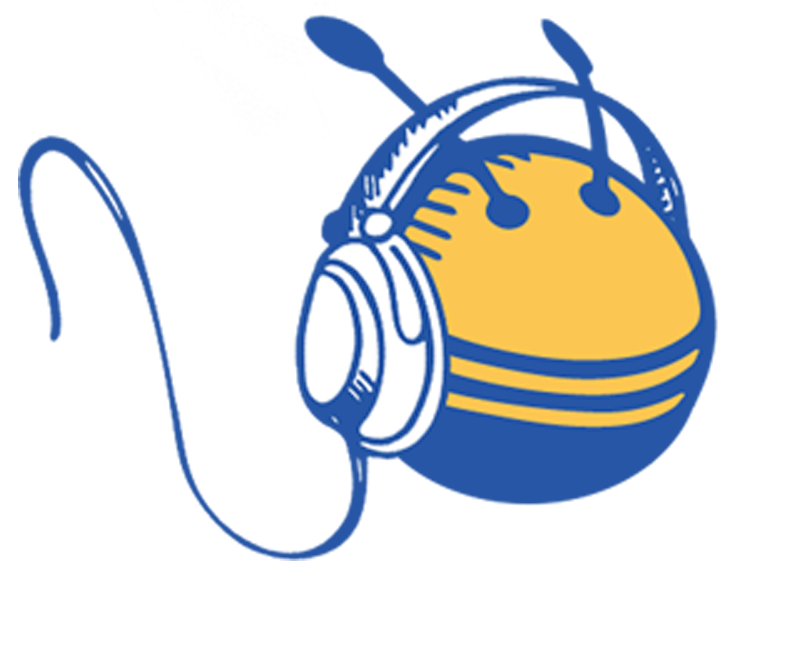
 Check out the BuzzStream Podcast
Check out the BuzzStream Podcast

